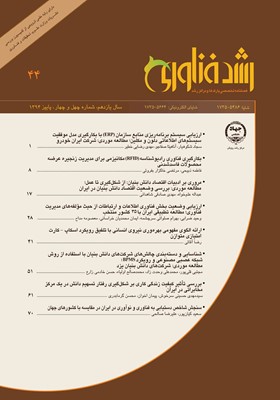بکارگيري فناوري راديوشناسه (RFID) مکانيزمي براي مديريت زنجيره عرضه محصولات فاسدشدني
محورهای موضوعی : مديريت تکنولوژيفاطمه ذبیحی 1 * , مرتضی خاکزار بفروئی 2
1 - پژوهشکده توسعه تکنولوژی
2 - دانشگاه تربیت مدرس
کلید واژه: فناوري راديوشناسه, کالاي فاسدشدني, قيمتگذاري, نقطه سربه سر, طرح ارتقا,
چکیده مقاله :
فناوري راديوشناسه به عنوان فناوري پيشرو ميتواند براي کاهش اتلاف در زنجيره تأمين مواد غذايي مفيد باشد. اين فناوري ميتواند اطلاعات محصولات را دريافت کرده و در کاهش هزينهها، مؤثر باشد. بيشترين چالشها براي مديريت زنجيره تأمين مربوط به کالاهاي فاسدشدني و با عمرکوتاه، بهخصوص مواد غذايي هستند. تنوع در تعداد کالاها، رديابي و پيگيري جريان کالا در طول زنجيره تأمين، عمر کم، حجم بالاي محصولات و نياز به کنترل دما در زنجيره تأمين از جمله چالشهاي موجود ميباشد. ريسک مواد غذايي ميتواند در هر مرحله از زنجيره تأمين مواد غذايي ظاهر شود، در نتيجه تعريف نقاط کنترلي براي بدست آوردن اطلاعات مواد تشکيلدهنده، توليد و تاريخهاي خاص (فروش، مصرف) و غيره، و مهياکردن آن به شيوهاي شفاف براي ارائه به عرضهکنندگان زنجيره تأمين و مصرفکنندگان ضرورت دارد. يکي از بهترين راهحلهاي ممکن استفاده از سيستم راديوشناسه بوده که به مديريت زنجيره تأمين در حل مشکلات لجستيکي کالاهاي فاسدشدني کمکهاي فراواني خواهد کرد. در اين مقاله به بررسي مدل کسب و کار مالي پيادهسازي سيستم راديوشناسه در رديابي موادغذايي پرداخته شده است. براي روشنشدن موضوع يک مطالعه موردي از بکارگيري سيستم راديوشناسه در زنجيرهاي از فروشگاههاي رفاهي در تايوان ارائه شده است. در اين مطالعه موردي با معرفي دو طرح ارتقايي 4 و 6 ساله، سود و هزينههاي مرتبط با اجراي راديوشناسه براي توليدکنندگان، توزيعکنندگان و خردهفروشان زنجيره تأمين فروشگاه رفاهي تجزيه و تحليل شده است.
Radio Frequency Identification (RFID), a leading technology could be useful for reducing the supply chain food. The RFID can be effective with receiving product information and reducing costs. The greatest challenges are the supply chain management of perishable goods, especially the food. Variation in the number of goods, tracking and follow-up the flow of goods throughout the supply chain, low life expectancy, high volume products requiring temperature control in the supply chain is some of the challenges. The risk of food at each stage of the supply chain of food can occur, resulting in the definition of management to obtain information, ingredients, date of production (sales, consumption), etc., and provide it in a transparent manner to provide supply chain suppliers and consumers is necessary. One of the best possible solutions is using of RFID that help the supply chain management in perishable goods logistics. This paper examines the business model of the financial implementation of RFID in tracking food. To clarify the subject, a case study RFID system using in Taiwan welfare chain stores has been providing. In this case by introducing two upgrade projects 4 and 6 years old, profit and costs associated with the implementation of RFID for manufacturers, distributors and retailers in the supply chain of convenience stores have been analyzed.
1- S. Piramuthu, P. Farahani, and M. Grunow, "RFID-generated traceability for contaminated product recall in perishable food supply networks," European Journal of Operational Research, vol. 225, no. 2, pp. 253–262, 2013.#
2- S.O. Tromp, H. Rijgersberg, F.I.D.G. Pereira da Silva, and P.V. Bartels, "retail benefits of dynamic expiry dates – simulating opportunity losses due to product loss, discount policy and out of stock," International Journal of Production Economics, vol. 139, pp. 14–21, 2012.#
3- F. Tijun, T. Feng, D. Sheng, and L. Shuxia, "Impact of RFID technology on supply chain decisions with inventory inaccuracies," International Journal of Production Economics, vol. 159, pp. 117–125, 2015.#
4- D. Tanner, "Applications for RFID Technologies in the Food Supply Chain," Reference Module in Food Science, 2016.#
5- M.C. O'Connor, "Cold-chain project reveals temperature inconsistencies," RFID Journal http://www.rfidjournal.com/articles/view?2860, 2006.#
6- J.-P. Emond and M., Nicometo, "Shelf-life Prediction and FEFO Inventory Management with RFID," Cool Chain Association Workshop.Temperature Measurements When, Where and How? Knivsta,Sweden, 2006.#
7- K. Koutsoumanis, P.S. Taoukis, and G.J.E. Nychas, "Development of a safety monitoring and assurance system for chilled food products," International Journal of Food Microbiology, vol. 100, no. 1-3, pp. 253–260, 2005.#
8- R. Stockute, A. Veaux, and P. Johnson, "Paul Johnson Homepage," Logistic Distribution. Available from:, 2006.#
9- I.-H. Hong, J.-F. Dang, Y.-H. Tsai, C.-S. Liu, W.-T. Lee, M.-L. Wang and P.-C. Chen, "An RFID application in the food supply chain: A case study of convenience stores in Taiwan," Journal of Food Engineering, vol. 106, no. 2, pp. 119–126, 2011.#

